Did you know Emmet Dalton, the man who was one of Collins' most trusted men on the day of his death, was also responsible for bringing "Braveheart" to Ireland?
When Major General Emmet Dalton of the National Army died on his 80th birthday on March 4, 1978, not one member of the current Fianna Fáil government attended his funeral. It shows the stubbornness and the pettiness of both political parties a half-century after the end of the Irish Civil War.
Dalton’s biggest fault was that he was one of Michael Collins’ favorite generals. He was in charge of shelling the Four Courts in Dublin in June 1922, made an amphibian landing in County Cork that General Douglas MacArthur would have been proud of, and was with Collins at the time of his death at Béal na mBláth on August 22, 1922.

Love Irish history? Share your favorite stories with other history buffs in the IrishCentral History Facebook group.
American born
Emmet Dalton was born in Fall River, Massachusetts on March 4, 1898, to Irish-American parents. When Emmet was a child his prosperous father, James, moved the family to Dublin, settling in Drumcondra. James was very active in John Redmond’s Irish Parliamentary Party (IPP) and fully supported its Home Rules agenda.
Emmet was educated at the O’Connell School on North Richmond Street (Scoil Uí Chonaill), a hotbed of nationalism. Three of the 16 patriots executed by the British in 1916 were alumni: Seán Heuston, Eamonn Ceannt and Con Colbert. Future Irish President Seán T. O’Kelly was also a student there as was Ernie O’Malley.
But the connection that would last for life for Emmet and his brother Charlie would be their relationship with the Lemass brothers, Noel and Seán. The relationship between Emmet and Seán, who would become the fourth Taoiseach in Irish history, would survive the Civil War and result in the resuscitation of the Irish Film Industry.
Emmet joins the British Army
Emmet joined the Irish Volunteers when they came into being in 1913. When Redmond bolted the Volunteers, leaving such radicals as Tom Clarke and Seán MacDiarmada in charge, he told his followers that it was their patriotic duty to join the British Army in the defense of such small nations as Belgium. Emmet followed this directive, and lying about his age, became a second lieutenant in the Dublin Fusiliers. He did so without conferring with his parents who were naturally upset.
At the time of the Easter Rising, Emmet was in Cork but was distraught at what had happened in Dublin.
By the summer of 1916, he was in France—just in time for the Battle of the Somme. The events in Ireland still troubled Dalton, but he went to Buckingham Palace on May 2, 1917, to receive the Military Cross from King George V.
As a protest as to what the British were doing in Ireland Dalton refused to bow to the King to receive his decoration and stood erect. Dalton spent the rest of the war in the Middle East before returning to France where he instructed the newly arrived American Expediency Force (AEF) on how to operate the British Lewis machine gun. Dalton was cashiered from the British Army with the rank of Captain in April 1919.
Charlie Dalton paves the way for Emmet
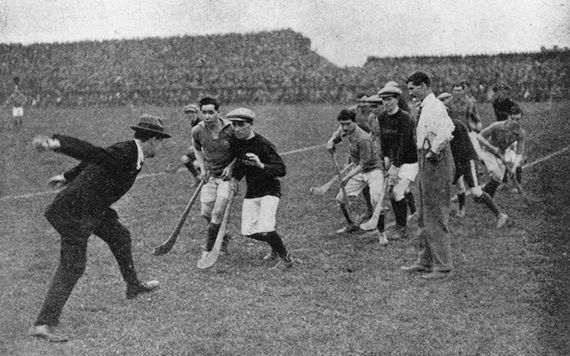
Bloody Sunday in 1920. Image: Getty.
By the time Emmet got back to Dublin his younger brother Charlie was a member of the IRA and working for Michael Collins in the intelligence office at #3 Crow Street. Emmet soon found out that things were hot in Dublin as the Dalton house in Drumcondra was constantly being raided as the British hunted for Charlie and ended up arresting Emmet instead.
On November 21, 1920, Bloody Sunday, Charlie accompanied shooters from Collins’ Squad, the Twelve Apostles, as they hunted British Secret Service agents at #28 Pembroke Street. Charlie’s job was to gather intelligence papers from the dead men but was so disturbed by all the shooting and bloodshed he botched the job.
That same morning blocks away Seán Lemass, brought in to supplement the Squad, was in charge of the raid at #119 Baggot Street where he shot several Secret Service agents dead. Most believe that most of the northside men, like Lemass and Dalton, had fled across the Liffey on ferries. But it ends up that Lemass and Dalton spent the night together in South William Street, smack in the middle of Dublin and not far from Dublin Castle itself.
When Charlie fell on hard times later in life, Lemass, now Eamon de Valera’s Minister for Supplies during World War II, wrote a letter to Charlie’s wife supporting Charlie’s application for a disability pension because of his experiences working for Collins during the War of Independence. Not many Irishmen would have shown such grace to a Civil War opponent:
“I was associated with your husband the latter part of 1920,” wrote Lemass. “At that time, he, I, and some others were lodging together at the Dispensary Building, South William Street. All those lodgings there were on active service but not all with the same unit.
"Your husband, Charles Dalton, was I understood, engaged in intelligence work. He was of highly-strung disposition, and on more than one occasion I came to the conclusion that the strain of his work was telling on his nerves. I first became seriously concerned about him, however, on the evening of Sunday, Nov. 21st, 1920 (since called ‘Bloody Sunday’). On the morning of that day, a number of British government agents in Dublin were shot.
It was your husband’s duty to accompany a party of IRA to one house occupied by four of these agents, all of whom were shot. He returned subsequently to the billet at S. Williams Street and I realized that he had become unnerved by his experiences of the morning. So obvious was his condition that I and one of the others took him out for a walk although it was an undesirable and risky thing to do and might have drawn attention to the billet. It did not improve his condition and during that night he was, on occasions, to be hysterical.”
It was around the time of Bloody Sunday that Emmet joined the IRA. The IRA was in need of serious military training, something that Dalton had done during the Great War. He had an interview with Oscar Traynor, Commandant of the Dublin Brigade, and was appointed Assistant Director of Training of the IRA’s General Headquarters Staff. By the summer of 1921, he was promoted to Director of Training.
Earning Collins’ trust
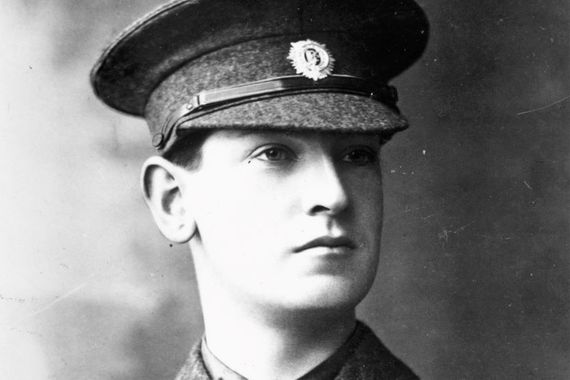
Michael Collins in uniform. Image: Getty.
The Dalton brothers combined on one of the most daring adventures during the War of Independence—attempting to spring Seán MacEoin from Mountjoy Gaol. Charlie helped steal a British armored car and Emmet, dressed in his British officer’s uniform, gained entry to Mountjoy to rescue MacEoin. It was Collins’ brainchild and Emmet thought it was folly but went along with it. He also went to confession because he knew what the British would do to him if they captured him.
“It was, I suppose,” said Emmet, “suicidal but it nearly came off, probably because it was so outrageously silly.” Dalton got as far as the warden’s office but could not spring MacEoin. He made his escape, but Collins was impressed with how Dalton maneuvered himself into Mountjoy and considered it “a successful failure.” Collins made sure that MacEoin was subsequently released during the Truce.
“A bond developed between the two men,” wrote Sean Boyne in his biography of Dalton. “Clearly, Collins saw in Emmet Dalton a brave, dynamic young man who could handle major tasks. He obviously respected Dalton’s military experience, his coolness, and his ‘can-do’ attitude, and would entrust Dalton with a range of crucial tasks over the following year. Dalton, for his part, looked up to Collins. Dalton would write later of Collins that he never knew a man to possess such an amazing personality—he described Collins as a severe taskmaster but with his mesmeric personality the Big Fellow ‘could make the weakest of us feel strong with the overflow of courage.’ ”
Boyne also wrote that “Dalton felt that Collins had come to trust him and thereafter Dalton had ‘infinite faith’ in Collins. It was the beginning of a close, working relationship between the two men. The operation had enhanced Dalton’s reputation for courage and coolness under pressure. He himself insisted that it was Collins’s leadership qualities that encouraged people like himself to undertake major operations that they would otherwise have had their doubts about.”
The Truce and beyond
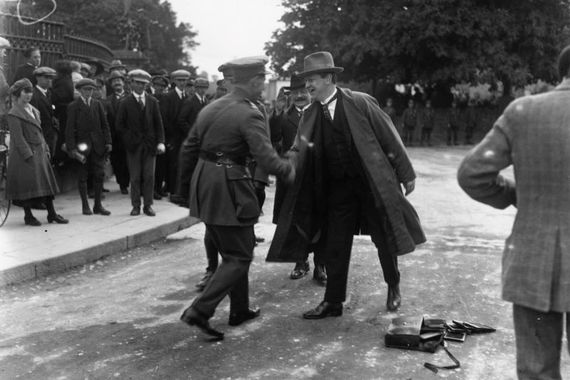
Michael Collins in June 1922. Image: Getty.
Collins went to London in October 1921 to negotiate the Truce with British Prime Minister David Lloyd George and Winston Churchill. Dalton was immediately given an assignment which he detailed in a Witness Statement sent from London in October 1951.
“I accidentally gave birth to the first Irish Flying Unit,” he wrote. “When the truce was declared and it was decided by the Dáil that Michael Collins was to cross as one of the Irish Plenipotentiaries accompanied by less important people that the General Headquarters Staff were gravely concerned about his safety, being conscious that should the Treaty negotiations break down whilst Collins was in London, the entire Irish Army position would be jeopardized.”
So Dalton went out and purchased an airplane that could get Collins back to Dublin in case of disaster. “From this beginning,” Dalton wrote, “grew what is now known is known as the Irish Air Force.” It was at this time in the fall of 1921 that Dalton also joined the radical Irish Republican Brotherhood, which Collins was the head of.
Dalton was a trusted member of Collins’ Treaty delegation, which included veterans like Ned Broy, Collins’ spy in the RIC. He advised Collins on military affairs and in the two months that Collins and Dalton were in London they became closer, living in the same building together.
With the Treaty signed and ratified by the Dáil, Dalton became the Chief Liaison Officer as the British left Ireland, working out of an office at the Gresham Hotel in O’Connell Street. His portfolio was full. One of his first jobs was to get men who had been involved on Bloody Sunday out of British custody in case the Treaty collapsed. He was present as Dublin Castle was turned over to the new Irish government in January 1922 and participated when such British Army strongholds like Beggars’ Bush and Portobello Barracks were turned over to the Irish government. He also had to liaison with the British as the anti-Treaty forces made breaches in the Treaty.
Taking the Four Courts and Cork City
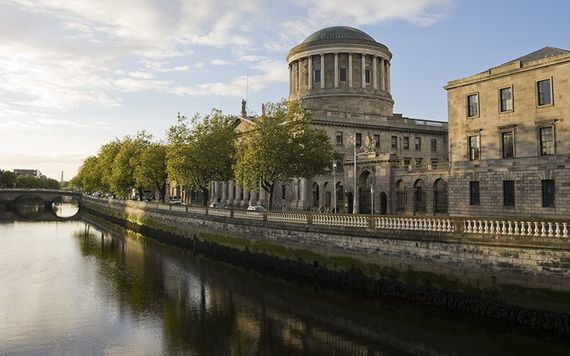
The Four Courts today. Image: RollingNews.ie.
In April the Four Courts were taken over by anti-Treaty forces led by General Rory O’Connor with Seán Lemass as his second in command. By June, after the assassination of Sir Henry Wilson in London by two IRA men, Winston Churchill decided the rebels in the Courts had to go. By this time Dalton was a Major General in the National Army and Director of Operations. Collins consulted with him about what was the best way to get the anti-Treaty forces out of the Four Courts. Dalton’s Great War experience played into his decision-making.
“Dalton believed,” wrote Sean Boyne in his Dalton bio, “that the use of guns would have a ‘very demoralizing effect on a garrison unused to artillery fire.’ But he also realized that the employment of the guns against the sturdy stone Four Courts buildings would be ‘quite insignificant.’ It fell to Dalton as Chief Liaison Officer, to procure the required eighteen-pounder field guns from the British.”
In the end, the rebels fled the Courts with Seán Lemass and Ernie O’Malley retreating to the Jameson Distillery in close-by Bow Street.
Dalton’s next challenge from Collins was to retake Cork, Collins’ home county. Dalton adopted a strategy that General Douglas MacArthur used in Korea thirty years later at the Battle of Inchon. “Dalton was a strong advocate of seaborne landings by troops to overcome resistance by republican forces,” wrote Boyne. “The Free State approach from the sea was to prove of particular importance in Munster, large parts of which were under the control of anti-Treaty forces, especially Cork city and county.
The republicans had cut roads, destroyed bridges and blocked railway lines, making military advances by land difficult. Dalton had talks with Collins and [Richard] Mulcahy and it was finally decided that the best way to attack was by sea, and that Dalton would personally lead one of the major landing operations in Cork. He firmly believed in the element of surprise so he intended to steam up the River Lee by night, and then ‘capture Cork while they [the enemy] were asleep.’@
Dalton’s strategy wrote Boyne, “involved a three-pronged assault from the sea, with the main force landing at or near Cork city, with two other landings, one to the east at Youghal and another to the west, at Union Hall in Glandore Harbour, between Skibbereen and Rosscarbery.”
His Cork strategy had a strong effect on turning the tide in the Civil War.
“Dalton’s capture of Cork,” wrote Boyne, “was a severe blow to the morale of the republican forces. Cork was the last bastion of the anti-Treaty movement and now their forces had been pushed ignominiously out of the city. In one of his initial reports to Commander-in-Chief Collins after taking Cork, Dalton declared that the morale of the enemy was ‘practically broken.’
A senior anti-Treaty commander, Liam Deasy, would later describe how Republicans had been ‘taken by surprise’ when the Free Staters began sending troops at strategic points around the Irish coast. ‘The greatest blow of all was the landing at Passage West on 8 August.’ ”
With Collins at Béal na Bláth
With Cork seemingly secure, Collins decided to pay a visit, not to gloat, but to possibly negotiate with anti-Treaty republicans and bring them into the Free State fold. There are many conflicting reports and rumors surrounding the death of Michael Collins on August 22, 1922, at Béal na Bláth (the Mouth or Gap of the Flowers in the Irish). In an extraordinary interview with RTÉ’s Cathal O’Shannon which aired on the evening of Dalton’s death, Emmet Dalton visited Béal na Bláth and told the story of that fateful day.
It was about 7:30 in the evening when Collins convoy arrived at Béal na Bláth. Dalton surmised that about “half-a-dozen” riflemen were taking aim at them. He knew they were in a “perilous” position. “I said to the Commander-in-Chief [Collins] ‘Drive like hell!’ But he elected to stop here and fight them, you see. So we did.”
Dalton estimates the skirmish went on for about “fifteen to twenty minutes maximum.” Collins was moving about and was out of Dalton’s sight. When they found Collins Dalton said “He had been shot. He was lying there with a gaping wound to the back of his head…I bandaged the wound and Seán O’Connell said an Act of Contrition to him. I knew he was dying if not already dead.”
Dalton went on to comment that “it was quite obvious to me from my experience it was a ricochet bullet. It could only be a ricochet or a dum-dum. There was no exit wound just a great gaping hole.”
Collins did not speak, and Dalton thought him already dead. Dalton admitted he was “completely grief-stricken.” Collins body was brought back to Dublin via boat and even the British navy gave Collins the General Salute and sounded the Last Post.
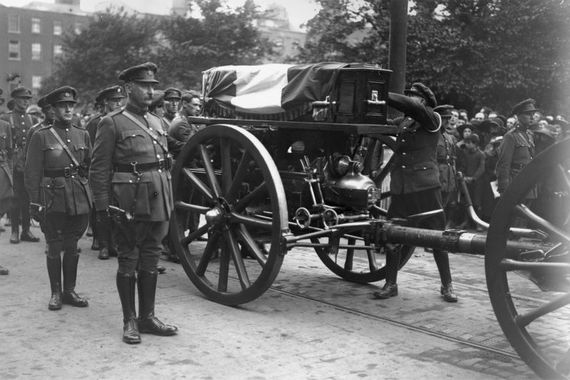
Michael Collins' funeral. Image: Getty.
“My love of Collins—I use no other word—hasn’t altered one iota in the passage of time,” Dalton said in the RTE interview. “He was a man whom I didn’t know all that long, but who I knew terribly well in a very short time. And whereas I don’t think he showed me any special favors he was always very kind and very understanding. And he seemed to place a lot of trust in me and in my judgment and this is a most rewarding feeling from someone you admire so much.
“A man of immense ability, untiring energy and thoughtfulness for others. At the end of a day when most people would look for a rest I have known him to go around looking for the relatives of people who have suffered a loss to try and give them some comfort—and this from a man who never had a free moment for himself. He was a patriot, a most courageous man and a great, great man.”
Dalton goes on to say that with Collins gone things changed in the Free State. He was appalled at the draconian methods the Cosgrave government wanted to use against the rebels and he resigned his commission. He was given the job as a clerk to the new Irish Senate which contained such luminaries as Douglas Hyde, who would go on to become the first president of Ireland, the irrepressible Oliver St. John Gogarty and the Archpoet, William Butler Yeats.
Dalton has some interesting things to say about Yeats: “The poet…who sometimes looked up and more often looked down…He didn’t intervene very much. He was a little ponderous. A very brilliant man I’m sure—but didn’t give much evidence of it in the Senate!”
Ardmore Studios
Dalton always had a flair for the dramatic and it’s not surprising that after leaving government service he would eventually—after selling such things as insurance, weighing scales and whiskey and participating in the sporting life with both golf and racehorses—settled into the movie industry. Golfing would eventually lead him to a relationship with David Rose, the head of the British branch of Paramount Pictures.
By 1943 he was Paramount’s sales supervisor for the North of England. In 1947 he went to work for Samuel Goldwyn, who ironically had made a picture based on the life of Collins called "Beloved Enemy" starring Brian Aherne as the Collins character and Merle Oberon as a Lady Laverty-type love interest.
The Dalton family had stayed in Dublin during the war while Emmet worked in England, but by 1950 he had moved his whole family to London. It was during this period he hooked up with American producer Hannah Weinstein who produced such series as “Colonel March of Scotland Yard,” starring Boris Karloff and the immensely popular “The Adventures of Robin Hood” starring Richard Greene.
The success of Robin Hood gave Dalton the idea to team up with the Abbey Players and make films of their plays. He knew he would need a place to make these films and decided to buy the 33-acre Ardmore property in Bray, County Wicklow, just twelve miles outside of Dublin, which made it close enough to do location shooting in the city. The cost of the property was a mere £5,000.
It is here that the Seán Lemass connection came into play again. Lemass was then the Minister for Industry and Commerce in de Valera’s last government and he was happy to help out Dalton. “So far,” Dalton wrote, “the Minister has proved to be enthusiastic and cooperative.” And on May 13, 1958 Minister Lemass was happy to officially open Ardmore Studios.
Over the years such films as “Shake Hands with the Devil,” starring James Cagney, “The Spy Who Came in from the Cold” with Richard Burton, “Braveheart” starring Mel Gibson, “My Left Foot” with Daniel Day-Lewis, and Veronica Guerin starring Cate Blanchett have been shot there.
Dalton also went on to produce nine films during the 1950s and ’60s. His Filmography at IMDB.com is rather interesting:
- Professor Tim (executive producer), 1957. Starring Ray McAnally.
- The Poacher’s Daughter (executive producer), 1957.
- Broth of a Boy (executive producer), 1959. This picture is significant in that it is the last movie that Barry Fitzgerald, the first Irish citizen to win an Oscar for Going My Way, would make.
- Home Is the Hero (executive producer), 1959. It starred American actor Arthur Kennedy and Irish character actress Eileen Crowe.
- This Other Eden (executive producer - uncredited), 1959. It starred Dalton’s daughter Audrey and was a vehicle for other Irish actors such as Milo O’Shea, Niall MacGinnis and Harry Brogan.
- Lies My Father Told Me (executive producer), 1960. It starred American actress Betsy Blair and Irish character actor Harry Brogan.
- Boyd’s Shop (executive producer), 1960. Another Eileen Crowe vehicle.
- The Webster Boy (producer), 1962. It starred American actor John Cassavetes.
- The Devil’s Agent (producer), 1962. An international cast was led by Macdonald Carey, Peter van Eyck, Marianne Koch, Christopher Lee and Samuel Beckett’s favorite female actress, Billie Whitelaw.
Like father, like daughter
Emmet wasn’t the only Dalton to make their mark in films. The move to London proved beneficial to daughter Audrey too. She was a student at the Royal Academy of Dramatic Arts (RADA) when spotted by a Paramount scout. Soon she was in Hollywood working on her first film “My Cousin Rachel” starring Olivia de Havilland and Richard Burton. Soon she was in “Titanic” with Barbara Stanwyck and Clifton Webb and “Casanova’s Big Night” featuring Bob Hope and Joan Fontaine. Audrey would go on to star in every major American television series from “Wagon Train” to “Bonanza” to “Police Woman” before retiring in 1978.
In an interview in ClassicFilmTVCafe.com in 2016, she fondly recalled moving to Hollywood. “I had always wanted to [act] ever since I was very little,” she said.
“I was fortunate enough that my family moved to London when I was 16. I later auditioned for the Royal Academy of Dramatic Art in London and was admitted. I was trained there and, while still at the Academy, a scout from Paramount Pictures saw me in a theater production. That led to an audition for a film in Hollywood. I came over for six months...and here I am. I’m not going to tell you how many years later,” she said with a laugh.
Bob Hope and his family took special interest in the Irish girl away from home. “He [Hope] was very, very sweet. In fact, when I first came here, I was 18 and on my own. He had a son and a daughter, who were a little younger than me by a couple of years. On Sunday evenings, he would sometime take me to dinner with his wife. They would come pick me and take me to dinner because they figured I needed a little looking after. He and Dolores were kindness itself.”
Alan Ladd, a friend of her father’s, also looked out for her: “Alan Ladd was wonderful to work with—very professional. He was very quiet off the set, very much a gentleman. I knew his family in Los Angeles. My father had known Alan because they were both into racehorses. When I came here, Alan was asked to keep an eye on me. He took me into his family. He had a daughter who was a student at UCLA and she and I became good friends. We’re still friends.”
Retirement and death
With the death of his wife Alice, Emmet lived a solitary life in London. Eventually, he was coaxed back to Dublin to live with his two daughters. He often went to California in winter to live with Audrey and avoid the harsh Irish winters.
There have been some revisionists who speculated that Dalton had actually murdered Collins that long-ago day at Béal na Bláth. It is utter nonsense and the inane, asinine stuff that conspiracy theories are made of.
And even in old age, Dalton retained his animosity towards de Valera.
“Dalton retained his low opinion of Éamon de Valera,” wrote Sean Boyne, “whom he blamed for the Civil War. He cannot have been pleased when de Valera was re-elected as President for another term in 1966, occupying the official residence, Áras an Uachtaráin in the Phoenix Park. In a letter to a friend in Dublin in August 1966, Dalton considered that the curse of the Civil War could be attributed to one man, ‘the sanctimonious, hypocritical megalomaniac’ in the Phoenix Park.”
Dalton would outlive de Valera and his friend Seán Lemass. He would be buried close to General Collins in Glasnevin Cemetery. Even though he was shunned at the grave by Fianna Fáil politicians, he was saluted by a contingent of the Old IRA led by Vinny Byrne, shooter extraordinaire of the Twelve Apostles.
Eighteen years after his death, the ghost of Major General Emmet Dalton was probably forced to smile when the movie Michael Collins, starring Liam Neeson, was filmed at Ardmore Studios, in a way binding Dalton’s early life and his later life neatly together in tribute to this great Irishman.
Dermot McEvoy is the author of “The 13th Apostle: A Novel of Michael Collins and the Irish Uprising” and “Our Lady of Greenwich Village,” both available in paperback, Kindle and Audio from Skyhorse Publishing. He may be reached at [email protected]. Follow him at www.dermotmcevoy.com. Follow The 13th Apostle on Facebook at https://www.facebook.com/13thApostleMcEvoy/
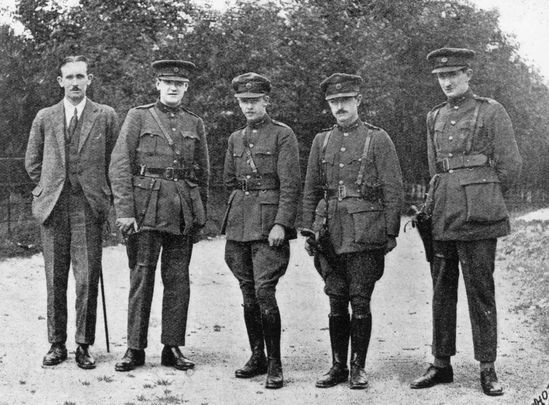



Comments